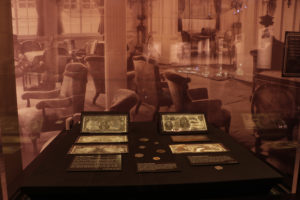Sail back in time
Traveling exhibit on display at Mayborn Museum in Waco
Story by Catherine Hosman
Contributed photos
 When you step onto the port of entry at the RMS Titanic exhibit at the Mayborn Museum in Waco you are handed a boarding pass with the name and brief biography of one of the passengers who sailed on the doomed ship.
When you step onto the port of entry at the RMS Titanic exhibit at the Mayborn Museum in Waco you are handed a boarding pass with the name and brief biography of one of the passengers who sailed on the doomed ship.
For as long as it takes you to view the displays you are that person. Did you perish or did you survive?
At the end of the exhibit is a memorial board listing the names of the victims and survivors based on class and crew.

Names are listed horizontally in alphabetical order. Look closely as you find out the fate of the person whose boarding pass you hold. What was it like for those people on that fateful journey? What was going through their minds as they scrambled for one of the lifeboats or held onto loved ones and strangers as they went down with the ship?
This Titanic exhibit is one of several traveling the country, displaying artifacts from the debris field found at the bottom of the ocean where the ship perished. Premier Exhibitions has been collecting artifacts since 1987 and now has an inventory of 5,500 pieces — 200 are on display in Waco.

“They (divers from Premier Exhibitions) don’t go onto the ship but stay in the debris field,” said Rebecca Nall, assistant director of Exhibits, Communication and Visitor Services.

The ship went beyond carrying passengers. To create additional revenue, the RMS (Royal Mail Ship) Titanic and its sister ships also carried mail and cargo.
“It was one of three ships that included the Britannica and Olympian,” Nall said.
This might be a once-in-a-lifetime opportunity for Central Texans to view actual artifacts from the RMS Titanic. Learn how first-, second- and third-class passengers traveled and the strict segregation. First-, second- and third-class passengers each had their own deck or level and they were not allowed to mingle with the other classes. They also had their own dining room and china.
On display is first-, second- and third-class passenger china with a menu of food service for each. The higher the class, the richer the food. Also on display are cooking pots from the galley, wine and beer bottles and even a champagne bottle.

Au gratin dishes that sunk to the bottom of the ocean floor coffined in a wooden cabinet that disintegrated over time are now in a glass display case. As the cabinet wore away from its contents, the dishes remained in the same order. They were found encased in the soft sand of the sea bottom. A photograph of the dish discovery hangs behind the exhibit.
Leather suitcases and wallets protected items such as women’s jewelry, hair pins and other personal items. They were preserved and are included in the exhibit. Shaving brushes and mugs, jewelry, wallets and paper money of that era are also on display. They help illustrate the human toll.
“The Titanic was owned by American JP Morgan and built in Ireland by an all British crew,” Nall said. “A first-class traveler paid $2,500 back then, $50,000 in today’s money, compared to a third-class passenger who paid $40, which is equal to $900 in today’s money for a family of four.”

While some first-class passengers stayed in parlor suites with a private bath, third-class passengers slept in bunk beds in rooms that oftentimes included strangers unless an entire family was traveling. There were only two bathtubs for 700 third-class passengers — one for women and one for men. In an era when people only bathed once a week, it wouldn’t have been too difficult to schedule a bath on what would have been a two-week voyage.
Photographic panels of the Titanic’s construction in Belfast, Ireland, line the walls of the exhibit and illustrate the ship’s short life. Images of passengers — that tell stories of survival or biographies of those who died — also hang on the walls.

Two of the most prominent first-class passengers on the ship were Isidor and Ida Strauss. Mr. Strauss was the owner of Macy’s Department Stores. They were represented toward the end of the 1998 movie “Titanic” by John Cameron as an older couple on deck arguing over which one of them will get into the lifeboat. There is little room for everyone and Mr. Strauss insisted his wife get in the boat. She refused. Instead she chose to stay on the ship with her husband and died with more than 1,500 passengers and crew.

As visitors continue through the exhibit, they come upon a growing iceberg. They can lay hands on the surface and feel the frigid cold that passengers felt as they jumped into the icy waters in the quest to escape the sinking ship.
Seven hundred people survived the chilling water and air temperature, rescued when the RMS Carpathia arrived, plucking them from crowded lifeboats.
If you go

The exhibit is on display through Jan. 6 at the Mayborn Museum, 1200 S. University Parks Drive, Waco.
Call 254-710-1110 for more information.
Admission to the exhibit is members, $6; adults, $19; children, age 2 to 12, $13; and seniors, 65+, $16. Group discounts available with advance reservations.
The ticket includes admission to the rest of the museum, so plan a day, pack a lunch and see what the rest of the museum has to offer.




